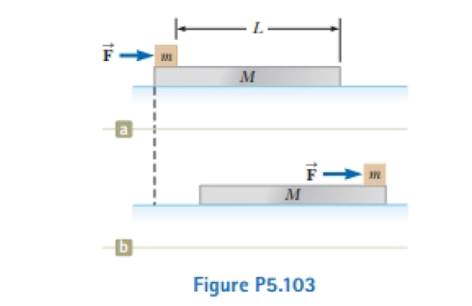
A block of mass m = 2.00 kg rests on the left edge of a block of mass M = 8.00 kg. The coefficient of kinetic friction between the two blocks is 0.300, and the surface on which the 8.00-kg block rests is frictionless. A constant horizontal force of magnitude F = 10.0 N is applied to the 2.00-kg block, setting it in motion as shown in Figure P5.103a. If the distance L that the leading edge of the smaller block, travels on the larger block is 3.00 m. (a) in what lime interval will the smaller block make it to the right side of the 8.00-kg block as shown in Figure P5.103b? (Note: Both blocks are set into motion when

(a)
The time interval small block make it to the right of the larger block.
Answer to Problem 5.103CP
The time interval small block make it to the right of the larger block is
Explanation of Solution
Given info: The mass of the smaller block is
The acceleration due to gravity is
The net force in
Here,
The frictional force between the smaller block and the larger block is,
Here,
Substitute
The net force in
Here,
Substitute
Substitute
Thus, the acceleration of the smaller block is
For the larger block,
The net force in
The force
Substitute
Substitute
Substitute
Thus, the acceleration of the larger block is
Consider
From the second equation of motion the distance moved by the smaller block in time
The initial speed of the smaller block is
Substitute
From the second equation of motion the distance moved by the larger block in time
The initial speed of the larger block is
Substitute
For the smaller block to reach the right edge of the larger block,
Here,
Substitute
Substitute
Rearrange the above equation for
Conclusion:
Therefore, the time interval small block make it to the right of the larger block is
(b)
The distance the larger block moves in the process.
Answer to Problem 5.103CP
The larger block moves
Explanation of Solution
Given info: The mass of the smaller block is
The acceleration due to gravity is
From part (a) the distance the larger block moves in the process is,
Substitute
Conclusion:
Therefore, the larger block moves
Want to see more full solutions like this?
Chapter 5 Solutions
Physics for Scientists and Engineers, Technology Update (No access codes included)
- 2. Max is swimming across a river that is 42.6 m wide. He can swim at 1.6 m/s and heads 20° to the right of the vertical. There is a current pushing him more to the right and it has a speed of 0.30 m/s. Determine the time it takes him to cross the river and find out how far downstream he ends up. Draw the diagram.arrow_forwardpls help asaparrow_forwardpls help asaparrow_forward
 Glencoe Physics: Principles and Problems, Student...PhysicsISBN:9780078807213Author:Paul W. ZitzewitzPublisher:Glencoe/McGraw-Hill
Glencoe Physics: Principles and Problems, Student...PhysicsISBN:9780078807213Author:Paul W. ZitzewitzPublisher:Glencoe/McGraw-Hill Physics for Scientists and Engineers: Foundations...PhysicsISBN:9781133939146Author:Katz, Debora M.Publisher:Cengage Learning
Physics for Scientists and Engineers: Foundations...PhysicsISBN:9781133939146Author:Katz, Debora M.Publisher:Cengage Learning Principles of Physics: A Calculus-Based TextPhysicsISBN:9781133104261Author:Raymond A. Serway, John W. JewettPublisher:Cengage Learning
Principles of Physics: A Calculus-Based TextPhysicsISBN:9781133104261Author:Raymond A. Serway, John W. JewettPublisher:Cengage Learning University Physics Volume 1PhysicsISBN:9781938168277Author:William Moebs, Samuel J. Ling, Jeff SannyPublisher:OpenStax - Rice University
University Physics Volume 1PhysicsISBN:9781938168277Author:William Moebs, Samuel J. Ling, Jeff SannyPublisher:OpenStax - Rice University Physics for Scientists and Engineers with Modern ...PhysicsISBN:9781337553292Author:Raymond A. Serway, John W. JewettPublisher:Cengage Learning
Physics for Scientists and Engineers with Modern ...PhysicsISBN:9781337553292Author:Raymond A. Serway, John W. JewettPublisher:Cengage Learning Classical Dynamics of Particles and SystemsPhysicsISBN:9780534408961Author:Stephen T. Thornton, Jerry B. MarionPublisher:Cengage Learning
Classical Dynamics of Particles and SystemsPhysicsISBN:9780534408961Author:Stephen T. Thornton, Jerry B. MarionPublisher:Cengage Learning





